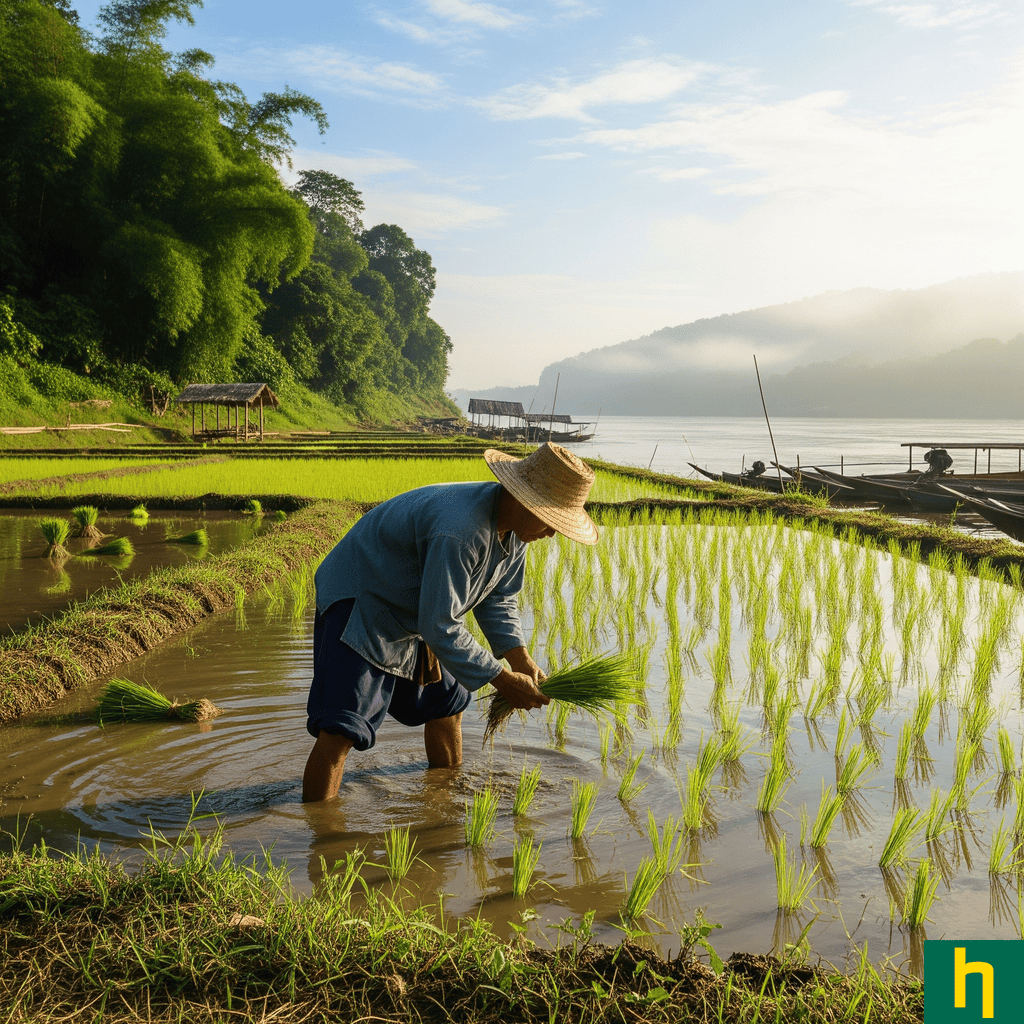Isan food is not for the faint of heart. Highlighted when the late Anthony Bourdain first ventured into Isan, when he was awed by its raw authenticity, proclaiming its food to be “the most delicious, fascinating, and adventurous” in Thailand.
For many, the mention of Thai food usually conjures images of creamy green curries, Pad Thai, or the sourness of a Tom Yum Goong. These dishes have captivated palates worldwide. But beyond the familiar, there’s a subset of Thai cuisine so distinct it feels like a different country. This is the gastronomic realm of Isan, Thailand’s vast northeastern region.
Isan Food Early Beginnings

Bordered by Laos to the north and east, and Cambodia to the south, Isan is home to roughly one-third of Thailand’s population – a staggering 22 million people. Yet, its culinary traditions remain, for international travellers remain an enigma.
From the mid-14th to the mid-19th centuries, authorities/rulers/the Siamese government resettled significant populations of ethnic Lao people in what is now Isan.
These forced mass migrations of ethnic Lao populations crossed the Mekong River into what is now Isan. And it was these events that became a foundational moment in shaping the food landscape of Isan, a fusion born of displacement and resilience.
The landscape of Isan is challenging. Thailand’s northeastern plateau is a stark contrast to the plains of Central Thailand. In Issan, a hot, dry season and unpredictable rains dictate the weather.
With less access to abundant water compared to other parts of Siam, the people learned to maximise what few resources they had. Sticky rice (Khao Niao), a grain well-suited to the region’s conditions, became a fundamental staple. And with unpredictable harvests and a need to preserve fish from the Mekong, fermentation was essential too.
Cultural Crossroads: Influences Shaping Isan Food

For centuries, the people of Isan shared a common heritage, language, and way of life with the Lao. This connection is evident in their love of sticky rice. The shared consumption of Khao Niao is so fundamental that a common, affectionate term for the people of Isan is “Luk Khao Niao” – “Children of Sticky Rice.”
Beyond sticky rice, fermented fish sauce Pla Ra serves as the very soul of Isan flavour. Its distinct aroma and umami taste result from fermentation lasting months, sometimes even years. It’s the Pla Ra that gives iconic dishes like Som Tum (papaya salad) and Larb (minced meat salad) their depth and complexity. Indeed, while Pla Ra might be an acquired taste for some visitors, for the people of Isan, it’s non-negotiable. It’s such a part of the region that archaeological digs along the Mekong have even unearthed ancient pottery jars at Ban Chiang, dating back as far as 3,000 years, containing remnants of Pla Ra.
Its challenging climate created a remarkable resourcefulness among the people. Limited access to fresh protein year-round meant that preserving food was a must. This meant fermentation for fish and meat, as well as pickling for vegetables. They are a people who are deeply reliant on foraging for wild herbs and edible plants, known as Pak (vegetables or greens).
These ingredients add bitter, astringent, or aromatic tastes that balance the flavours of the main dishes. It’s a cuisine born not of abundance, but of ingenuity and a deep connection to the land.
Isan Food vs The Rest: What Makes it Different?
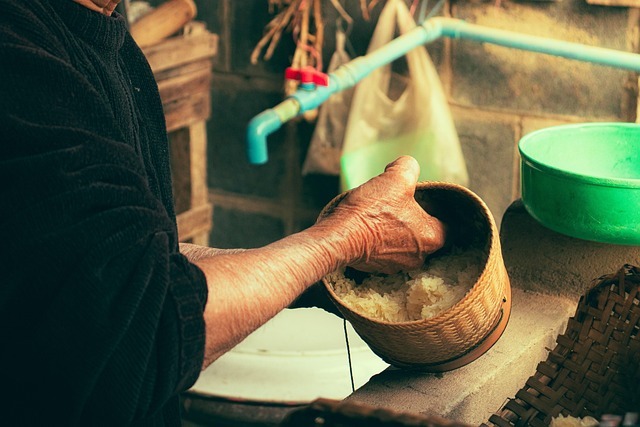
To the uninitiated, all Thai food might appear to share a common thread of spicy, sweet, sour, and salty. But delve deeper, and the distinct identity of Isan emerges.
The main distinction begins with the very foundation of the meal: sticky rice, Khao Niao. While central and southern Thailand predominantly consume jasmine rice, the people of Isan eat sticky rice at almost every sitting.
Traditionally, they serve this glutinous rice, steamed to a chewy texture, in small woven bamboo baskets. Diners don’t eat it with cutlery; instead, they roll small portions into a ball, using it to scoop up the accompanying dishes with the rice ball.
Bold Flavours
Then there’s the bold flavours. Central Thai cuisine, often refined by royal court traditions, tends towards a delicate balance, often with coconut milk. Isan, by contrast, embraces an aggressive flavour profile. The emphasis shifts to spicy, sour, and intensely salty, with sweetness taking a lesser role. The architect of this taste is Pla Ra (fermented fish sauce). More aromatic than Nam Pla (fish sauce) used elsewhere in Thailand, Pla Ra provides a powerful, earthy umami that defines Isan dishes.
Some foreign travellers to Isan describe it as an overpowering, cheesy, or even “barn-like” scent. Yet, many of these find themselves utterly addicted to it in the end.
Also, Isan cooking techniques often lean into simplicity and efficiency, born of a largely agrarian lifestyle. Grilling (e.g., gai yang – grilled chicken, moo ping – grilled pork skewers) is a dominant method, providing a smoky complement to the spicy salads. The pounding of ingredients in a mortar and pestle is a critical technique for blending components in salads like Som Tum. You’ll find a noticeable absence of the rich, coconut-milk-based curries so prevalent in Southern and Central Thai cooking, replaced instead by lighter, herb-heavy broths or intensely flavoured meat and vegetable salads.
Finally, the generous use of fresh, raw herbs and vegetables (Pak) is a hallmark. These are served as accompaniments to be eaten alongside the main dishes. This practice reflects the region’s long tradition of foraging and its emphasis on fresh, local ingredients. It’s this embrace of raw vitality, pungent ferments, and robust spice that sets Isan cuisine apart, offering a culinary experience that’s as authentic as it is unforgettable.
Must-Try Isan Dishes for Beginners
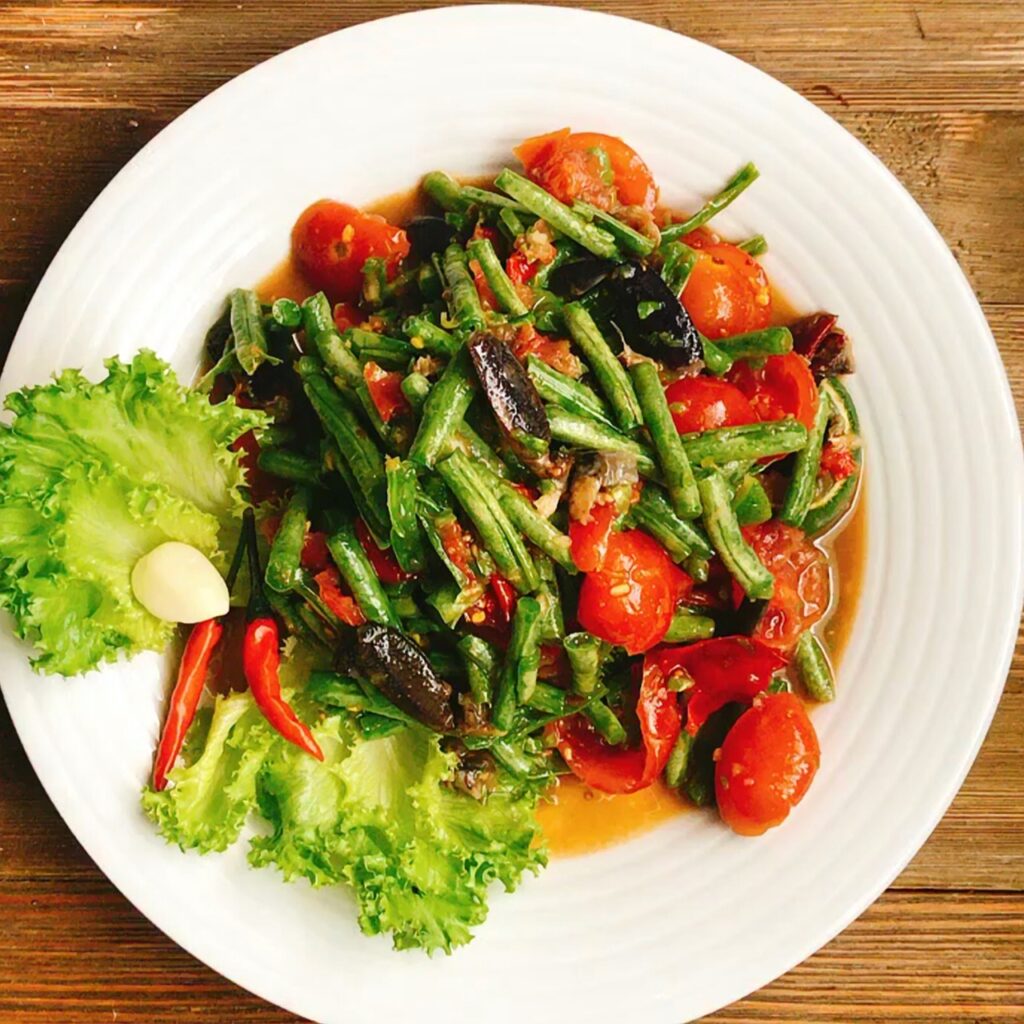
Som Tam Laos Style
No journey into Isan food can begin without an encounter with Som Tum (papaya salad). This dish, more than any other, is the ambassador of Isan. While the ubiquitous “Som Tum Thai” found in many international restaurants offers a sweeter, peanut-laden version, the true essence lies in its regional variations.
The authentic Isan rendition includes Pla Ra (fermented fish sauce), adding a deeply savoury kick that’s utterly addictive. You might encounter a Som Tum Lao heavy on Pla Ra. Or Som Tum Pu Pla Ra with fermented crab, offering layers of umami and a satisfying crunch. The rhythmic sound created by pounding chillies, garlic, and papaya is the very heartbeat of any Isan market or street food stall.
Som Tum is so beloved and versatile that it’s estimated there are dozens, if not hundreds, of variations across Thailand and Laos, using everything from mangoes to cucumbers as a base.
Larb Isan
Next on the essential list is Larb (Minced Meat Salad). This deceptively simple-sounding dish is a masterclass in fresh, bold flavours and textures. Typically featuring minced pork, chicken, or beef, Larb is dressed with lime juice, fish sauce, and ground roasted rice, providing a unique nutty aroma and a scattering of fresh herbs like mint, cilantro, and spring onion. It’s light yet satisfying, offering a zesty counterpoint to the heat of the chillies.
Gai Yang
No meal is complete without Gai Yang (Grilled Chicken). Whole chickens are marinated, often overnight, in a flavourful blend that includes garlic, white peppercorns, cilantro roots, and sometimes lemongrass. Then, the meat is slow-grilled over charcoal, resulting in succulent meat with a crispy, smoky skin. It’s the perfect protein to temper the spice of the salads.
Nam Tok
Nam Tok (grilled meat salad) offers a variation on Larb. While similar, the crucial addition of Khao Khua, Nam Tok uses thinly sliced grilled meat (often pork neck or beef) rather than minced, providing a chewier texture and smoky flavour from the grill. The name “Nam Tok” is translated to “waterfall,” as in the juices that “fall” from the grilled meat as it’s sliced.
Tom Saap
For those who enjoy a warming, tangy broth, Tom Saap (spicy pork ribs soup) is a revelation. Isan’s answer to Tom Yum, this intensely flavoured soup features tender pork ribs simmered with lemongrass, galangal, kaffir lime leaves, and a generous kick of fresh chillies and lime juice. It’s spicy, sour, and deeply comforting.
Sai Krok Isan
Finally, for a delightful street food snack, seek out Sai Krok Isan (Isan Sausage). These small, fermented pork and rice sausages are grilled until slightly charred with a distinctive sourness from the fermentation process. They are served simply with raw cabbage, sliced ginger, and bird’s eye chillies, creating a harmonious burst of flavours and textures.
Navigating Your Isan Food Adventure
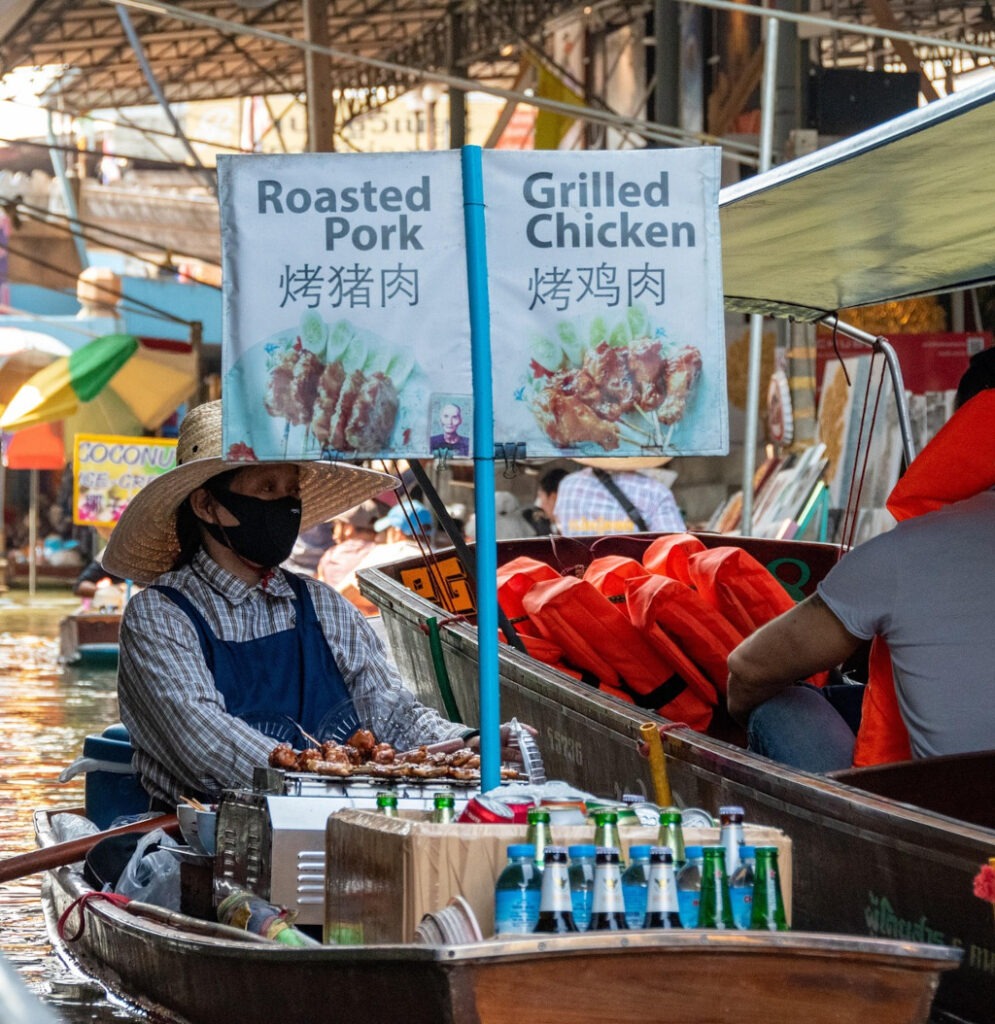
Unlike the more formal dining establishments found in Thailand’s tourist districts, the Isan cuisine resides in its informal, bustling spaces. Your most authentic encounters will be at street food stalls and local markets. Here, under the glare of fluorescent light, you’ll find the thud of the Som Tum pestle, the sizzle of grilling meats, and the chatter amongst delighted diners. These places are social hubs, epitomising the communal spirit of Isan folk. Look for establishments, often simple and unpretentious, where the majority of patrons are local Thais – a sure sign of authenticity.
Enhancing the Isan Experience
Spice levels: The fiery nature of Isan food is legendary. If you’re not accustomed to intense heat, a polite “mai phet” (not spicy) or “phet noi” (a little spicy) is advisable. But be warned: even “a little spicy” in Isan can still deliver a considerable kick for the uninitiated. It’s a matter of perspective for chefs accustomed to high levels of chilli.
Pla Ra Preference: As we’ve established, Pla Ra is fundamental. For the hesitant, request “mai sai Pla Ra” (without Pla Ra) for certain dishes, particularly Som Tum. However, to fully appreciate the depth and character of genuine Isan flavour, I highly recommend an open mind.
Sticky rice etiquette: Remember, Khao Niao is eaten by hand. Take a small, manageable ball, flatten it between your fingers, and use it to scoop up the sauces and components of your chosen dishes. See it as an immersive experience connecting you directly to what you’re eating.
Ordering for sharing: Isan meals are inherently communal. Don’t order just one dish per person; the joy comes from ordering several different plates – a Som Tum, a Larb, some Gai Yang, a soup – and sharing them amongst dining companions. This allows for a delightful exploration of varied textures and complementary flavours. And how Isaan food should be eaten.
Ultimately, navigating your Isan food adventure is about more than just finding the right dish. It’s about the lively atmosphere, the shared laughter, the unique textures, and bold flavours. Don’t be afraid to try new things, to get your hands sticky, and to sweat a little from the spice – you’ll unlock a truly unforgettable dimension of Thai cuisine.
Conclusion: Your Isan Food Journey Begins Now!
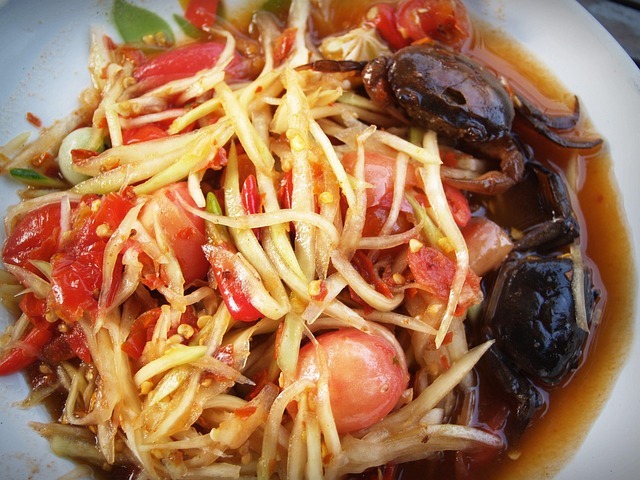
Isan is Thailand’s largest region by both land area and population. Yet, for years, its food remained largely unsung on the global stage, overshadowed by the more ‘refined’ central Thai court cuisine. This only makes its burgeoning international recognition all the more significant.
Isan boasts an incredibly rich cultural identity, vividly expressed through its dishes. Although it’s Thailand’s most economically challenged region, Isan food tells a powerful story. It’s truly the food of the people, born from the land and reflecting a deep connection to nature and community.
Isan dining is inherently communal, a celebration of shared plates and boisterous conversation.
For millions from the northeastern provinces, Isan food is the ultimate comfort food and a powerful taste of home. Even in the megacity of Bangkok, specialised Isan restaurants thrive, serving homesick migrants and curious urbanites alike. The smell of grilling gai, or freshly pounded Som Tum, brings back childhood memories from sun-drenched villages.
Isan Food – Step Out of Your Comfort Zone
Should you find yourself wandering through a busy market in Udon Thani or simply seeking out an authentic Isan eatery in your city, with Isan food, it’s all about stepping out of your comfort zone. Embrace the aromas and fiery spices.
And in doing so, experience how the bold, honest flavours define this remarkable cuisine. Your foodie journey through Thailand truly isn’t complete until you’ve savoured the soul of Isan.
Isan Food FAQs
What is Isan food, and how is it different from other Thai cuisines?
Isan cuisine is the food of Thailand’s northeastern region, which shares strong cultural and culinary ties with Laos. Unlike the more commonly known Central Thai food, which often uses coconut milk in many curries, Isan dishes are characterised by their bold, assertive flavours—intensely spicy, sour, and salty. Sticky rice (Khao Niao) is the staple carbohydrate, and common ingredients include fermented fish sauce (Pla Ra), fresh herbs, and various grilled meats.
What are some must-try dishes in Isan cuisine?
Three of the most iconic Isan dishes are often found together as a meal. Som Tum is a spicy green papaya salad, a famously refreshing yet fiery dish. Larb is a minced meat salad, seasoned with lime juice, fish sauce, herbs, and toasted rice powder, while Gai Yang is a simple but flavorful grilled chicken, often marinated with a sweet and savoury sauce.
Why is sticky rice so important in Isan food culture?
Sticky rice (Khao Niao) is the fundamental staple of the Isan diet, eaten with almost every meal. It’s traditionally eaten with one’s hands, rolled into a small ball and used to scoop up sauces and side dishes. Its dense, glutinous texture makes it a perfect complement to the spicy, salty, and sour flavours of Isan cuisine.
What unique ingredients are commonly used in Isan dishes?
A key element that distinguishes Isan food is its reliance on fermented ingredients. The most notable is Pla Ra, a pungent fermented fish sauce that provides a deep, savoury saltiness. The cuisine also uses a variety of foraged herbs and plants that give the dishes their unique, rustic flavours, such as toasted ground rice that adds a nutty texture and aroma to dishes like Larb.
How are Isan sausages (Sai Krok Isan) made?
Isan sausages, or Sai Krok Isan, are a popular street food known for their distinctively sour taste. They are made from a mixture of fermented pork and sticky rice, which is stuffed into a casing. The fermentation process gives the sausage its characteristic tangy flavour and a unique aroma. They are often served grilled and accompanied by fresh ginger, cabbage, and chillies.

